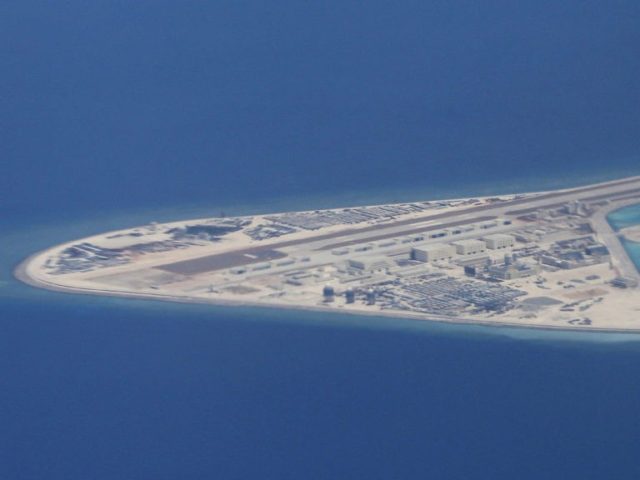A report published Thursday indicates that China has continued developing military and surveillance facilities on illegally constructed artificial islands in the South China Sea more than a year after an international tribunal ruled these constructions illegal.
The Asia Maritime Transparency Initiative (AMTI) at the Center for Strategic and International Studies (CSIS) warned this week that China “remains committed to advancing the next phase of its build-up—construction of the infrastructure necessary for fully-functioning air and naval bases on the larger outposts.”
AMTI focused on artificial constructions in the Spratly and Paracel Islands, claimed by the Philippines and Vietnam. China claims almost the entire South China Sea, spanning territory belonging to those countries as well as Malaysia, Brunei, and Taiwan. Indonesia has also expressed concern about a growing Chinese presence near its Natuna Island.
A 2016 ruling from the Permanent Court of Arbitration at the Hague dismissed most of China’s claims in the region and deemed the constructions in the Spratly and Paracel Islands illegal. Chinese officials vowed to disregard the ruling, and Chinese media have referred to the ruling as “waste paper.”
Noting that China appears to have slowed down on building more artificial land, AMTI highlights significant upgrades to facilities on the most highly developed reefs in the Spratly and Paracels. Woody Island, which AMTI describes as “China’s military and administrative headquarters in the South China Sea,” now features an array of fighter jets and other military assets. This month, the state-run Global Times announced military drills by Y-9 aircraft in the region.
Other islands did feature new constructions, including:
larger hangars alongside the airstrip, work on large underground structures at the south of the island likely intended to house munitions or other essential materiel, a large communications/sensor array at the northeast end of the island, various radar/communications facilities spread around the islet, and hardened shelters for missile platforms at the south end.
Missile shelters and surveillance technology expanded in the region, as well. AMTI states that the new facilities “account for about 72 acres, or 290,000 square meters, of new real estate at Fiery Cross, Subi, and Mischief Reefs in the Spratlys, and North, Tree, and Triton Islands in the Paracels.”
The construction has alarmed officials from neighboring countries and the United States. “Further militarisation of outposts will only serve to raise tensions and create greater distrust among claimants,” Pentagon spokesman Marine Lt. Col. Christopher Logan told the Guardian on Friday.
China has dismissed these concerns, calling the development of facilities “completely normal.”
“We believe certain people who have ulterior motives are making mountains out of molehills and stirring up trouble,” Chinese Foreign Ministry spokesman Lu Kang told reporters on Friday in response to questions about the AMTI report. “It’s completely normal for China to conduct peaceful construction and build essential defense equipment on its own sovereign territory.”
Through its state media, the Chinese government protested instead on Friday about the growing Australian presence in the region. The head of the PLA’s navy is quoted in Friday’s People’s Daily complaining about Australia’s presence in international waters.
“The general situation in the South China Sea is positive, but the Australian navy’s recent actions in the region are against the consensus reached by the leaders of the two nations and hinder bilateral cooperation,” Commander Shen Jinlong reportedly said during a meeting with Australian Vice Admiral Tim Barrett on Thursday. Shen was reportedly protesting Australian military exercises in the region.
Reports this year confirmed that the Trump administration has planned to conduct more Freedom of Navigation Operations (FONOPs) in the South China Sea, in which Navy vessels conduct a peaceful passage through international waters in the region to reaffirm the freedom of all states to travel through the region.

COMMENTS
Please let us know if you're having issues with commenting.